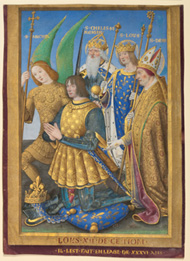 |

 |
 |
Louis XII of France Kneeling in Prayer, Accompanied by Saints Michael, Charlemagne, Louis, and Denis
|
 |
 |
|
The Hours of Louis XII was one of the greatest French manuscripts of its time. A private prayer book, it was painted in 1498/99 by Jean Bourdichon for the French king Louis XII during a period when the royal court in France was a key center of European art and culture. The manuscript's dramatic miniatures painted by Jean Bourdichon, a powerful court artist, are startling in their originality.
By the end of the 17th century the book's miniatures had all been removed and its text broken up. This exhibition brings back together 15 of the original miniatures from the book, along with a portion of the manuscript's text.
|
 |

 |
 |
February
Lent by the Lewis Collection, Rare Books Department, Free Library of Philadelphia
|
 |
 |
|
|
 |
The first text in a book of hours is the calendar, which lists the relevant feasts of the church year. The calendar of Louis' hours is richly illuminated with activities emblematic of particular months of the year. Here, for the winter month of February, an expensively dressed middle-class gentleman warms himself before a monumental fireplace.
Bourdichon was typical of the artists of his day in his interest in the diverse effects and varieties of light. In this miniature the red-hot glow of the flames reflects off of the man's gown. The astrological sign of Pisces appears in the sky above.
|
 |
 |

 |
 |
June
Lent by the Lewis Collection, Rare Books Department, Free Library of Philadelphia
|
 |
 |
|
On this calendar page, the lightly dressed farm laborer and the lush landscape suggest the warm air of a late spring day.
The calendar itself has been written out in an aesthetically ambitious manner, with the name of the month at the top presented with artful flourishes of the pen. Adding to the rich effect, the individual feast days in the calendar have been written in alternating colors of yellow and blue. Due to its importance, the feast day of Saint Barnabus is written in red, a so-called red-letter day.
|
 |

 |
 |
The Virgin of the Annunciation
Lent by the British Library, London
|
 |
 |
|
|
 |
The Hours of the Virgin is the core text of a book of hours. It was usually illustrated with a series of images depicting scenes from the life of Mary. Artists often showed special care painting the Annunciation because it illustrated the first prayer service of the Hours of the Virgin.
In this depiction of the Virgin of the Annunciation, Mary sits reciting her prayers and devotions, using her prayer book in the same manner that Louis XII might have used his. At the upper left, a small dove symbolizing the Holy Spirit descends towards Mary. A miniature opposite this image and now lost, would have shown the angel Gabriel appearing to tell her that she would be the Mother of God.
|
 |
 |

 |
 |
The Nativity
Victoria and Albert Museum. Purchased with assistance from the National Art Collections Fund and the National Heritage Memorial Fund.
|
 |
 |
|
The Nativity illustrated Terce, the fourth prayer service of the Hours of the Virgin. Bourdichon's Nativity, which shows the Virgin Mary kneeling before the infant Christ, displays his skill rendering three distinct sources of light. The first is the creamy white light that beams from the lantern held by Joseph. The second is the golden light emanating from the stars through the dilapidated roof. The third is the divine glow emitted by the Christ child himself.
In the late 15th century, nocturnal subjects were regarded as the ultimate test of an artist's abilities to represent different types of luminosity, in particular the play of light within darkness.
|
 |

 |
 |
Pentecost
Lent by the British Library, London
|
 |
 |
|
|
 |
Pentecost illustrated the Hours of the Holy Spirit, a series of devotional texts often found in a book of hours focusing on various attributes of the Holy Spirit. In this scene the Holy Spirit descends on Christ's disciples, endowing them with the ability to speak foreign languages and preach throughout the world. While the Bible does not mention the Virgin at this event, she often appears in medieval and Renaissance representations of the subject.
Bourdichon draws the viewer into this scene by offering, in the immediate foreground, a direct glance over the shoulders of two of the disciples. They are rendered in half-length and are placed low in the frame, thereby opening up the scene to the viewer.
|
 |
|
Bourdichon's Bathsheba Bathing illustrated the Penitential Psalms, which devout Christians prayed daily to obtain forgiveness for their sins. While Penitential Psalms were intended to aid religious devotion, on rare occasions, their accompanying imagery also served a more earthly function. Here Bathsheba, the Old Testament heroine, is plainly displayed. Her abundant blond hair seems to glow on the page with its golden highlights. Her small breasts are placed high and wide on her chest, her hips broad. These features match the highest standards of feminine beauty in 15th-century northern Europe.
Bathsheba is depicted as the temptress of King David, shown in the far distance, who seduced her. Clearly, she was also meant to tempt the book's patron, Louis XII.
The exhibition is located at the Getty Center, Museum, North Pavilion.
|
 |






